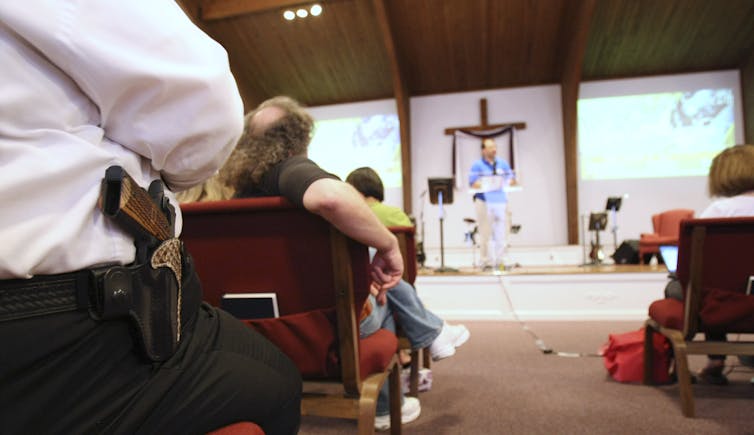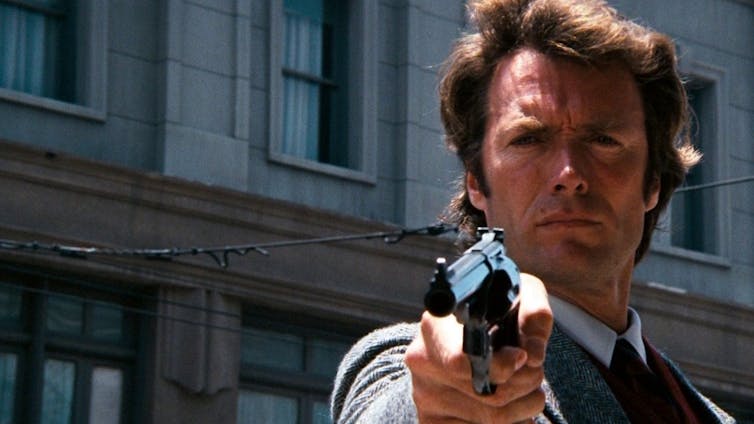Why Americans have long been fascinated by gunfighting preachers

The mass shooting on June 28 in Annapolis, Maryland, has renewed familiar concerns about America’s gun culture and gun policies.
Yet this was not the only June shooting to make national headlines.
Fox News and The Washington Post reported an earlier story involving the quick-thinking actions of a church leader who also happened to be a trained emergency responder. Spotting an armed carjacker exiting a Walmart Supercenter, in Oakville, Washington, the gun-owning pastor took pursuit – then shot and killed the man in the parking lot.
Compared to the Annapolis shooting, the Walmart incident offers a far more convenient narrative for gun-rights activists. At the same time, it highlights the intersection between America’s gun culture and its religious cultures.
In this, the event is hardly unique. As I’ve found in my research for a study of “Outlaw Preachers and Profane Prophets,” the image of the gun-toting preacher has recurred with remarkable persistence in U.S. history and culture.
‘With a Bible and a gun’
The Walmart shooting joins a long tradition of stories about well-armed American preachers – both real and fictional – who seem to embody national attitudes toward guns and religion, violence and justice.
Just picture Jesse Custer, the protagonist of the popular AMC TV series “Preacher.” One typical episode finds Jesse, in his preacher’s collar, firing round after round from a semiautomatic rifle to protect his little Texas church from the malevolent forces that threaten it.
On rock band U2’s 1993 song “The Wanderer,” originally titled “The Preacher,” singer Johnny Cash summons another version of this resonant archetype – that of the preacher who journeys forth with God on his side, armed with the Book of Life in one hand and an instrument of death in the other:
I went out walking with a Bible and a gun …
It’s telling that the song’s composer, Bono, should have written “The Wanderer” specifically for Johnny Cash. Growing up in Dublin, Ireland, Bono had experienced enough of “Bibles and guns” during the decadeslong clashes between (mostly Catholic) Irish nationalists and (mostly Protestant) British loyalists. And Bono ordinarily sings his own lyrics.
In this case, though, it’s as if the Bible-and-a-gun theme required an American icon to sing it. But why should that be so?
A Christian country
One answer is suggested by two notable features of U.S. culture. First, this remains a remarkably Christian country. It has the largest Christian population in the world, with some 70 to 83 percent of Americans identifying as Christian.
Second, the U.S. has a uniquely robust gun culture, as well as the world’s highest rates of gun ownership and extraordinary levels of gun violence.
Put these national characteristics together – the religion and the guns – and it’s not hard to see the appeal of figures, both real and fictional, that combine the two.
Consider the real-life example of the “pistol-packing pastor” – a Pentecostal preacher, named James McAbee, from Beaumont, Texas. McAbee has earned a reputation for offering firearm training in his own church.
Other such examples are not hard to find in American history. Back in the early 1900s, there was the Reverend J. Frank Norris, one of the country’s most popular preachers, who was widely known as “the pistol-toting divine.” He also once fatally shot an unarmed man during an argument, according to historian Barry Hankins.
Norris pleaded self-defense and was acquitted. Few would call his actions heroic, yet they seem only to have increased his appeal for his many fans.
These examples illustrate the extent to which, historically, many Americans have not only tolerated but celebrated the conjunction of preachers and firearms. But this is hardly the full story.
My research into the cultural representations of gun-slinging ministers suggests that such figures appeal to Americans’ interest in vigilante justice – in the capacity of a lone hero to save the rest of us when our institutions fail to.
Righteousness and retribution
The attractions of such vigilante justice help to explain the popularity of Westerns, especially those – like the classic 1953 film “Shane” – in which a lone horseman rides into town, has a shootout or two, and then rides off heroically into the sunset.
Country singer Willie Nelson combined that popular narrative with the figure of the preacher in his hugely successful 1975 music album “Red Headed Stranger.” That album tells the story of a man, called only “the preacher,” who ultimately shoots and kills his unfaithful wife and her lover.
We may not like that turn of events, but the album itself presents the preacher’s actions as justified, even heroic: a fantasy of righteous retribution.
In the 1985 Western “Pale Rider,” Clint Eastwood plays another character known only as “the Preacher.” Like Nelson’s album, this film marries a classic Western scenario to the weaponized preacher theme. In the mold of other Western heroes, Eastwood’s character rides into a small town from parts unknown and rescues a rural community from the malevolent forces that threaten it.

Watching Eastwood’s preacher at work, audiences can enjoy some of the same pleasures provided by Eastwood’s other famous vigilante character, Dirty Harry: a ruthlessly effective police officer whose methods often run afoul of what’s strictly legal. But with “Pale Rider,” viewers enjoy the additional thrill of watching a “man of God” take down the bad guys – with the aid of his trusty six-shooter.
Where other vigilantes might appeal to their own, individual codes of justice, the preacher figure carries the authority to discharge God’s justice. His vengeance carries always the suggestion that it’s divinely inspired.
The avenging preacher
The idea of the gun-toting preacher thus showcases the power of individual self-assertion, while also often emphasizing the importance of protecting and preserving a wider community.
It also resonates with specific features of American religious life today. These include public debates among pastors over the appropriateness of concealed carry in the pulpit and of “open-carry celebrations” at church – not to mention the NRA’s contention that only “a good guy with a gun” can stop a bad guy with one.
![]() With a Bible in one hand and a gun in the other, the avenging preacher confirms the view that true justice cannot be enforced by institutions alone – and that God is on the side of those who would take the law into their own hands when necessary.
With a Bible in one hand and a gun in the other, the avenging preacher confirms the view that true justice cannot be enforced by institutions alone – and that God is on the side of those who would take the law into their own hands when necessary.